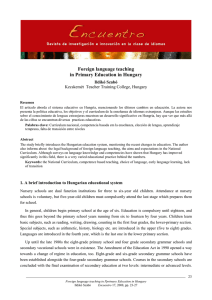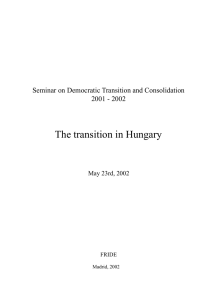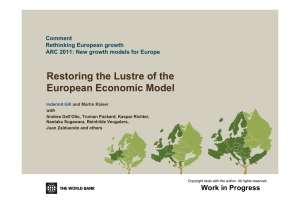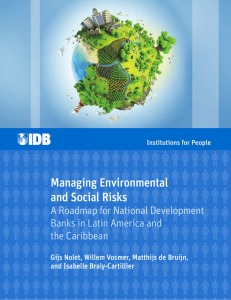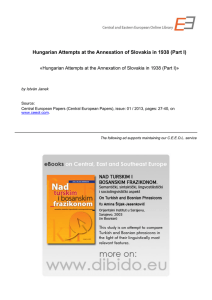Cover image of Working conditions in Hungary - Eurofound
Anuncio
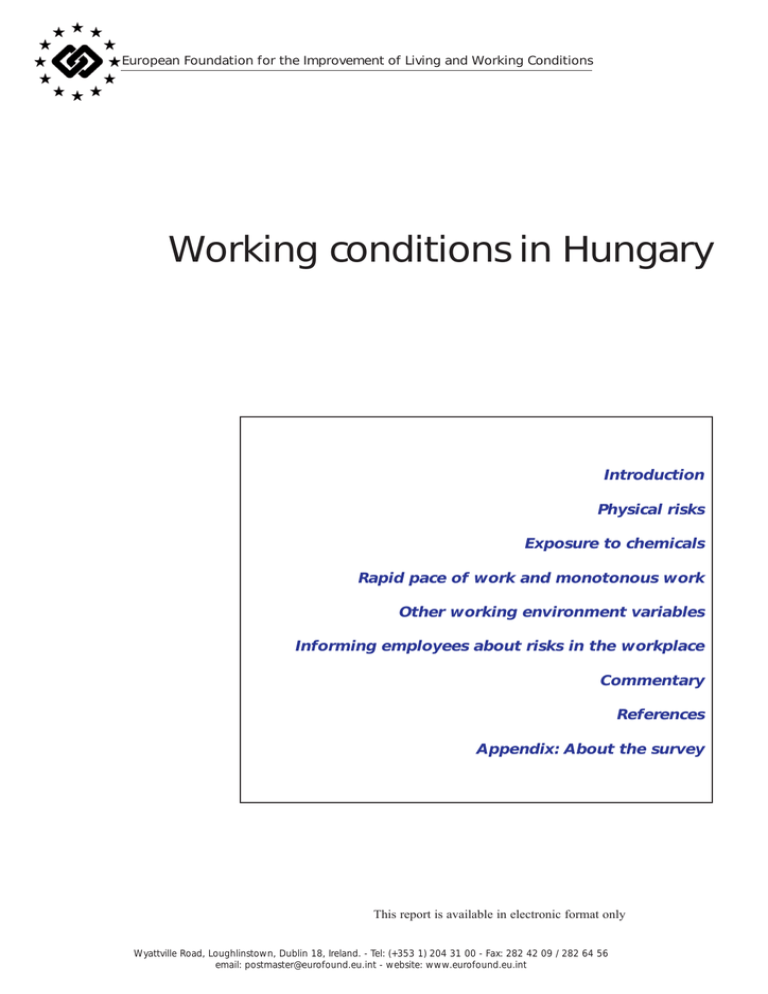
European Foundation for the Improvement of Living and Working Conditions Working conditions in Hungary Introduction Physical risks Exposure to chemicals Rapid pace of work and monotonous work Other working environment variables Informing employees about risks in the workplace Commentary References Appendix: About the survey This report is available in electronic format only Wyattville Road, Loughlinstown, Dublin 18, Ireland. - Tel: (+353 1) 204 31 00 - Fax: 282 42 09 / 282 64 56 email: [email protected] - website: www.eurofound.eu.int In 2001, Hungary carried out its first survey on the state of occupational health and safety in the workplace. The survey aimed to assess working conditions in order to promote the Hungarian National Programme of Occupational Safety and Health for improving quality of work and life, and to establish a database on working conditions that would be comparable with EU data. The results reveal that, with regard to physical factors, such as noise, vibration, temperature, uncomfortable working posture, heavy mental and/or physical workload, the proportion of employees affected is similar to that in the EU. However, in relation to exposure to chemicals, Hungary reports more than twice the exposure rate of the EU average. Introduction This report reviews the main results of the survey, The state of occupational health and safety in Hungary, which was carried out in 2001. The survey had two key objectives: to assess working conditions in Hungary in order to promote the Hungarian National Programme of Occupational Safety and Health for improving quality of work and life; and to establish a database on working conditions that would be comparable with EU data. The survey was conducted by the Public Foundation for Research on Occupational Safety (MKK), and the data were gathered through the Omnibusz surveys of the TÁRKI Social Research Institute, the Hungarian Labour Inspectorate (OMMF) and the National Centre for Public Health, according to the government bill 154/1999 on national statistical data gathering. In terms of methodology, the survey used as a model the Third European survey on working conditions 2000 questionnaire, designed by the European Foundation for the Improvement of Living and Working Conditions (2001). The survey was based on a representative sample of 3,751 respondents and the data were collected using structured face-to-face interviews (see the appendix for further details on the methodology and questionnaire). Respondents were chosen from all strata of the Hungarian working population: employees working full time or part time, self-employed entrepreneurs, and students and mothers on maternity leave if they had any kind of paid partial employment. Among the topics covered in the survey were: physical risks; exposure to chemicals; psychological and physical workload caused by a less than optimal working environment; other working environment variables; informing employees about risks in the workplace. Physical risks Noise in the working environment The survey results show that the proportion of employees affected by above-limit noise levels in the period surveyed was somewhat lower in Hungary than the average for the 15 EU Member States at the time (EU15), and the range of sectors affected was also different. In fact, in 2001, the permitted limit was lower in Hungary than in the EU15. © European Foundation for the Improvement of Living and Working Conditions, 2006 1 Working conditions in Hungary Table 1: Noise exposure, by proportion of employees affected, sector and occupation Proportion of employees affected by exposure to noise (%) Sectors most affected by noise exposure Hungary EU15 Hungary EU15 21.6 28 Coal mining, metal products manufacturing, textiles industry, wood processing Metal products excluding machinery, wood and cork products excluding furniture made of straw and wicker-work Jobs most affected by noise exposure Hungary EU15 Machine operators in light industry and wood processing, forestry workers, food processing workers Machine operators and assemble rs Sources: European figures based on the Third European survey on working conditions, 2001; The state of occupational health and safety in Hungary, 2002. Vibration at work According to the Hungarian survey findings, the employees most affected by exposure to vibration were men aged over 25 years employed in large companies. Table 2: Vibration at work, by proportion of employees affected, sector and occupation Proportion of employees affected by vibration (%) Hungary EU15 26.7 24 Sectors most affected by exposure to vibration Hungary Coal mining, peat cutting, forestry and wood processing, leather industry EU15 Construction Jobs most affected by exposure to vibration Hungary Forestry and agricultural workers, machine operators in light industry and wood processing EU15 Miners, construction workers, workers in transport and production of building material Sources: European figures based on the Third European survey on working conditions, 2001; The state of occupational health and safety in Hungary, 2002. High temperatures According to the survey results, those most affected by the risk of elevated temperatures in the workplace were men aged under 25 years employed in large companies. Table 3: High temperatures, by proportion of employees affected, sector and occupation Proportion of employees affected by high temperatures (%) Sectors most affected by exposure to high temperatures Hungary EU15 Hungary 27.1 20 Coal mining, peat cutting, forestry, metal products manufacturing, rubber and synthetics manufacturing, agriculture EU15 Basic metal products manufacturing Jobs most affected by exposure to high temperatures Hungary Workers in agriculture and forestry, food processing, transportation, postal services and telecommunications EU15 Miners, construction workers, drivers Sources: European figures based on the Third European survey on working conditions, 2001; The state of occupational health and safety in Hungary, 2002. 2 © European Foundation for the Improvement of Living and Working Conditions, 2006 Working conditions in Hungary Low temperatures Workers experiencing low temperatures can be divided into two main categories: those working in an open-air environment and consequently subject to climatic changes, and those who work in refrigerating plants of large food processing factories. Table 4: Low temperatures, by proportion of employees affected, sector and occupation Proportion of employees affected by exposure to low temperatures (%) Sectors most affected by exposure to low temperatures Hungary EU15 Hungary 19.7 23 Coal mining, peat cutting, recycling of waste materials, forestry, transport via waterways, agriculture EU15 Jobs most affected by exposure to low temperatures Hungary Food processing, Workers in agriculture, manufacturing of forestry, food processing, drinks, construction transportation and operators of mobile machinery EU15 Miners, construction workers, factory workers, masons Sources: European figures based on the Third European survey on working conditions, 2001; The state of occupational health and safety in Hungary, 2002. Ergonomic factors Lifting and moving heavy objects The data indicate considerable exposure to lifting and moving heavy objects in the sectors listed in Table 5. For instance, in the fishing industry, 75% of working time involves lifting or moving heavy objects. The sectors outlined are, to a great extent, traditional occupations requiring substantial manual labour. In 2001, the employees mainly affected were men aged under 25 years working in small enterprises. Table 5: Heavy lifting, by proportion of employees affected, sector and occupation Proportion of employees affected by exposure to heavy lifting (%) Hungary EU15 36.4 34 Sectors most affected by exposure to heavy lifting Hungary Woodworking, coal mining, forestry, transport via waterways EU15 Construction Jobs most affected by exposure to heavy lifting Hungary Workers in fishing, agriculture, forestry, food processing EU15 Miners, construction workers, factory workers, masons Sources: European figures based on the Third European survey on working conditions, 2001; The state of occupational health and safety in Hungary, 2002. Repetitive movements The proportion of employees in jobs requiring repetitive movements was practically the same in Hungary as the EU15 average. However, the relatively high number of workers affected in the forestry and agriculture sectors is a surprising result. Employees having to endure high levels of repetitive movements work mainly in medium-sized and large companies; men aged under 25 years of age are particularly vulnerable to this health risk in the workplace. © European Foundation for the Improvement of Living and Working Conditions, 2006 3 Working conditions in Hungary Table 6: Repetitive movements, by proportion of employees affected, sector and occupation Proportion of employees affected by exposure to repetitive movements (%) Hungary EU15 56.1 57 Sectors most affected by exposure to repetitive movements Hungary Woodworking, coal mining, forestry, transport via waterways EU15 Food and beverage industries Jobs most affected by exposure to repetitive movements Hungary Workers in wood processing, agriculture, forestry, food processing EU15 Maintenance workers Sources: European figures based on the Third European survey on working conditions, 2001; The state of occupational health and safety in Hungary, 2002. Painful and tiring positions In 2001, the proportion of employees in Hungary who reported working in strained bodily postures was lower than the EU15 average. This may be explained by the near demise of the mining industry in Hungary. Nevertheless, the proportion of activities carried out in a strained posture during the entire working day is still high in the sectors listed in Table 7. Table 7: Painful and tiring positions, by proportion of employees affected, sector and occupation Proportion of employees affected by exposure to painful and tiring positions (%) Hungary EU15 31.5 45 Sectors most affected by exposure to painful and tiring positions Hungary Coal mining, forestry, woodworking, construction, textiles industry, agriculture EU15 Food and beverage industries Jobs most affected by exposure to painful and tiring positions Hungary Construction workers, wood industry, agriculture, forestry, fishing EU15 Miners, construction workers, transport workers Sources: European figures based on the Third European survey on working conditions, 2001; The state of occupational health and safety in Hungary, 2002. Unfortunately, occupational diseases caused by ergonomic factors remain under-reported. This observation is also supported by the nationwide inspection campaign carried out by the National Labour Inspectorate (see the Hungarian National Programme of Occupational Safety and Health, in which the Labour Inspectorate concluded that at least 25% of work accidents are not reported). Exposure to chemicals Data referring to employees’ exposure to chemicals are surprisingly widespread, particularly in comparison with the EU15 average. One reason for this significant deviation may be the fact that, in 1981, Hungary was the first country in the world to make biological and chemical monitoring of the working environment a legal obligation. As a result, detailed data on the exposure to different chemicals (lead, organic solvents, organic esters of phosphoric acid, etc) are available. According to the survey on working conditions in Hungary, exposure to chemicals mainly affects men, as the jobs with the highest health risk are mostly occupied by men. 4 © European Foundation for the Improvement of Living and Working Conditions, 2006 Working conditions in Hungary Table 8: Exposure to chemicals, by proportion of employees affected, sector and occupation Proportion of employees affected by exposure to chemicals (%) Sectors most affected by exposure to chemicals Hungary EU15 Hungary 29.8 14 Leather industry, rubber and plastic manufacturing, fuel delivery, chemicals industry EU15 Chemicals industry Jobs most affected by exposure to chemicals Hungary Workers in health sector, mining, machine operators in manufacturing industries EU15 Miners, construction workers, factory workers, operators of office equipment Sources: European figures based on the Third European survey on working conditions, 2001; The state of occupational health and safety in Hungary, 2002. Rapid pace of work and monotonous work In Hungary, workers most affected by a rapid pace of work are women aged under 25 years of age working in industrial settings. Table 9: Rapid work pace, by proportion of employees affected, sector and occupation Proportion of employees affected by rapid work pace (%) Sectors most affected by rapid work pace Hungary EU15 Hungary 49.2 54 Raw material recycling from waste, textiles and leather industries, ma nufacturing of non-metal materials EU15 Hotel and restaurant Jobs most affected by rapid work pace Hungary Workers in food industry, machine operators in manufacturing industries, metal industry, mining EU15 Managers, customer service Sources: European figures based on the Third European survey on working conditions, 2001; The state of occupational health and safety in Hungary, 2002. In terms of the proportion of workers and sectors affected by increased work pace, the results correspond with those of the EU15; men aged under 25 years working in large companies are mainly affected. Table 10: Increased work pace, driven by management expectations Proportion of employees affected by management pressure on work pace (%) Hungary EU15 61.8 67 Sectors most affected by management pressure on work pace Hungary Manufacturing of non metal materials, fuel delivery, insurance, hotel and restaurant EU15 Hotel and restaurant Jobs most affected by management pressure on work pace Hungary Workers in trade industry, hotel and restaurant EU15 Customer service Sources: European figures based on the Third European survey on working conditions, 2001; The state of occupational health and safety in Hungary, 2002 © European Foundation for the Improvement of Living and Working Conditions, 2006 5 Working conditions in Hungary Table 11: Increased work pace, determined by machinery Proportion of employees affected by increased work pace, determined by machinery (%) Industrial sectors most affected by increased work pace, determined by machinery Jobs most affected by increased work pace, determined by machinery Hungary EU15 Hungary EU15 Hungary 20.5 22 Textiles industry, telecommunications, printing, food and beverage industries, metal industry Textile industry Machine operators in manufacturing, food industry, mining industry, mobile machine operators EU15 Machine operators, maintenance workers Sources: European figures based on the Third European survey on working conditions, 2001; The state of occupational health and safety in Hungary, 2002. In terms of the proportion of workers and sectors affected by monotonous work, the results correspond with those of the EU15. Men aged under 25 years and working in large companies are mainly affected. Table 12: Monotonous work, by proportion of employees affected, sector and occupation Proportion of employees affected by monotonous work (%) Sectors most affected by monotonous work Hungary EU15 Hungary EU15 49.7 45 Telecommunications, printing, raw material recycling from waste, textiles and leather industries, food and beverage industries Textiles and leather industries, food and beverage industries Jobs most affected by monotonous work Hungary Machine operators in manufacturing, food industry, mining industry, mobile machine operators EU15 Machine operators, maintenance workers Sources: European figures based on the Third European survey on working conditions, 2001; The state of occupational health and safety in Hungary, 2002. Other working environment variables The data highlight the importance of the use of personal protective equipment by employees in jobs carrying health and safety risks. According to the survey results, more than 30% of Hungarian employees are equipped with satisfactory personal protective equipment, which is a higher proportion than the EU15 average. It is important to note that not all employees need such equipment, so this represents a good coverage. However, one particular concern in Hungary is that many workers avoid using the protective equipment supplied, which often leads to an increased risk of serious occupational injury. 6 © European Foundation for the Improvement of Living and Working Conditions, 2006 Working conditions in Hungary Table 13: Use of personal protective equipment, by proportion of employees affected, sector and occupation Proportion of employees using personal protective equipment (%) Sectors most affected by use of personal protective equipment Jobs most affected by use of personal protective equipment Hungary EU15 Hungary EU15 Hungary 35 25 Coal mining, rubber and plastic manufacturing, metal industry Construction Machine operators in agriculture, food industry, mining industry, metal industry EU15 Construction workers Sources: European figures based on the Third European survey on working conditions, 2001; The state of occupational health and safety in Hungary, 2002. Informing employees about risks in the workplace With regard to awareness of workplace health and safety issues, the majority of employees are familiar with the risk factors of their workplace. It is the legal duty of employers to inform employees not only about the risk factors but also about the means of risk prevention. Unfortunately, however, risk awareness and adherence to preventive measures do not always correspond. Table 14: Risk awareness at work Worker awareness of risks in the workplace (%) Very good Quite good Quite poor Very poor 49.7 46.7 3 0.7 Source: The state of occupational health and safety in Hungary, 2002. Training provided by the employer On the basis of harmonised laws, providing education and information for employees has become the employer’s obligation. According to the survey findings, various training courses were provided for 50% of employees, but it is unlikely that all of the courses pertained to work safety issues. Table 15: Participation in training Proportion of employees participating in training courses (%) Total % of employees receiving training 1–7 days of training 8–30 days of training More than 30 days of training 49.7 46 3 0.7 Source: The state of occupational health and safety in Hungary, 2002. Commentary This report outlines the main results from the 2001 survey on the state of occupational health and safety in Hungary, commissioned by the Hungarian Labour Inspectorate. This was the first assessment carried out in Hungary in this field prior to the country’s accession to the EU in 2004. The main aims of the research were to: monitor the state of occupational health and safety; provide data on occupational health and safety for the development of regulations and guidelines; promote the Hungarian National Programme of Occupational Safety and Health and set priorities; © European Foundation for the Improvement of Living and Working Conditions, 2006 7 Working conditions in Hungary improve employees’ work–life balance; compare Hungarian and EU data on occupational health and safety. The main conclusions drawn from the results of the survey are that, with regard to physical factors, such as noise, vibration, temperature, uncomfortable working posture, heavy mental and/or physical workload, the proportion of employees affected is similar to EU15 figures. However, in relation to chemical exposure, Hungary reports more than twice the exposure rate of the EU15 average. Almost at the same time as the survey presented in this report was carried out, in 2001, the European Foundation for the Improvement of Living and Working Conditions launched a survey covering the 10 countries that would become new EU Member States in 2004, including Hungary, and two candidate countries at the time, Bulgaria and Romania. The survey, Working conditions in the acceding and candidate countries, encompassed a wider subject range, including working hours, bullying, violence and discrimination, income and payment systems. It provides an opportunity for comparing data among the then acceding and candidate countries. Author: Katalin Balogh, MKK References European Agency for Safety and Health at Work (OSHA), The state of occupational safety and health in the European Union (including the Risk sector project), Bilbao, August 1998. Hungarian Labour Inspectorate, Hungarian National Programme of Occupational Safety and Health 2001, 2002. Paoli, P. and Merllié, D., European Foundation for the Improvement of Living and Working Conditions, Third European survey on working conditions 2000, Luxembourg, Office for Official Publications for the European Communities, 2001. See also http://www.eurofound.eu.int/ewco/surveys. Public Foundation for Research on Occupational Safety, The state of occupational health and safety in Hungary 2001, Budapest, 2002. TÁRKI Social Research Institute, Working conditions in Hungary 2001, Omnibusz surveys, 2001. 8 © European Foundation for the Improvement of Living and Working Conditions, 2006 Working conditions in Hungary Appendix: About the survey Compiling the survey results of TÁRKI Omnibusz studies Some 3,571 respondents were included in the Omnibusz survey. The people were randomly selected from the data of the Central Processing Department of the Ministry of Internal Affairs and were proportionally representative of settlements of different sizes and geographical locations in Hungary. The researchers had to attempt to contact 1,500 people on the list once a month and were obliged to repeat the attempt on three occasions in case they failed the first time. Out of a possible maximum of 1,500 people each month, the final sample was as follows: May 2001: 704 persons June 2001: 661 persons July 2001: 652 persons August 2001: 605 persons September 2001: 643 persons October 2001: 486 persons Total: 3,751 persons List of survey questions Noise at work: Do you have to raise your voice if you want to speak to your workmate? Vibration: Do you experience vibration at work caused by hand tools or machinery? High temperature at work: Is the temperature at your work so high that you perspire even when you do not carry out any physical labour? Low temperature at work: During work, are you exposed to low temperatures either in closed or open spaces? Lifting and moving heavy objects: Do you have to lift and/or move heavy objects? Repeated movements at work: Do you have to carry out repeated hand or arm movements? Work with forced bodily posture: Do you carry out your work in a forced bodily posture? Handling chemicals: Do you come in contact with harmful substances or products in your work? Rapid pace of work: How frequently do you have to carry out work to a rapid pace? Pace of work demanded by social expectations: Does the pace of your work depend on people like customers, clients, passengers, patients? Pace of work driven by machinery: Is the pace of your work determined by products or machinery? Monotonous work: Does your work involve monotonous tasks? Use of personal protective equipment: In carrying out your work, how often do you have to wear personal protective equipment? © European Foundation for the Improvement of Living and Working Conditions, 2006 9 Working conditions in Hungary Informing employees about risks at work: Do you think you are well, quite well, rather badly or very badly informed about the risks that originate from substances, equipment, tools or products with which you are in contact during your work? Education, training provided by employer: In the past 12 months, have you participated in any kind of training involving knowledge on labour protection that was provided or financed by your employer? Muscle pain, pain in the dorsal or lumbar region: Do you think your work has an effect on your health? Do you experience pain in your back, neck, waist or in your muscles? Health deterioration caused by stress: Are you under stress? Do you feel exhausted or irritable? EF/06/47/EN 10 © European Foundation for the Improvement of Living and Working Conditions, 2006
